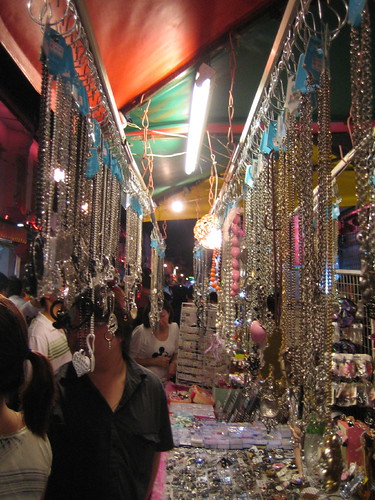
Jewellery on the street, courtesy of flickr and gurms
The forum featured brief statements on this question from Susan Cohn, professor Robert Baines, visiting French jeweller and writer Benjamin Lignel, and visiting New Zealand art historian Damian Skinner.
The main action of the evening was an argument between Cohn and Baines. Baines’ position was that jewellery as an art form took its reference from those traditions that preceded it. It was up to the jeweller as an individual to find their unique contribution to these traditions. By contrast, Cohn argued that what mattered most in contemporary jewellery was the wearer. To present her case, she proposed that one of the main reasons for the existence of contemporary jewellery was to deal with the way older women are rendered invisible in our culture.
It was a good argument that reflected two strongly held positions, but neither were likely to give ground. This intransigence does challenge us to think about contemporary jewellery as a heterogeneous practice. For Baines, the ultimate scene is at the bench, where the lone artist faces their own demons and angels in the task of bearing testament to the millennia of metalsmithing traditions. While for Cohn, the main arena is the street, where jewellery provides a currency for purchasing identities and pleasures. The position of each seems appropriate to their own domain.
So which is more legitimate, the bench or the street? Is the bench today an indulgence, focusing on a purely personal narrative disconnected from the surrounding world? On the other hand, is the street merely a scene of spectacle, that encourages short-term visibility rather than more profound and enduring meaning?
It’s likely that contemporary jewellery reflects a complex interconnection of its various spaces. This heterogeneity provides its energy and creative edge. Stepping back from the argument does let us regard the broader ecology of contemporary jewellery. But it also reveals an imbalance.
It can be argued that the bench has been the dominant space of contemporary jewellery, supported by dedicated artists, generous collectors and visionary gallerists. But today it is the street which provides a source of experimental possibilities, certainly in the Melbourne scene. Of course, this does not deny the importance of craft skill, which is necessary to give to the street a more enduring meaning than it currently supports.
I hope the argument between the bench and the street continues. It has much more territory to cover. But there is a further challenge beyond the specific scene of jewellery practice.
The heatedness of the argument regarding contemporary jewellery is a welcome sign of health in the scene. But the call for the field to expand can only achieve a limited success while the conversation is limited to other contemporary jewellers. This conversation is yet to be opened up to others – to not only to architects and sculptors, but also to philosophers, politicians and plumbers. The world needs contemporary jewellery.